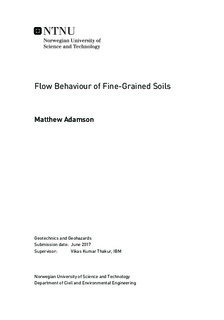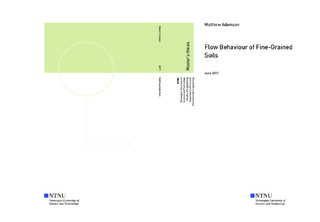| dc.description.abstract | Estimating the propagation and run-out distances of a landslide is a crucial part of risk assessment and mitigation for infrastructure development in Norway. Computational and numerical models are currently being developed to model sensitive clay slides in three dimensions, and aim to integrate geotechnical design calculations with in-situ and laboratory geotechnical data. These models rely on accurate input parameters for analysis, and therefore, the flow behaviour of sensitive clays is required.
Previous studies have applied the Herschel-Bulkley rheological model to Canadian and Norwegian clays in order to investigate their flow behaviour. Expanding on past studies, the flow behaviour of fine-grained soils has been investigated in this thesis. This was achieved by conducting quickness tests and viscometric experiments on quick clay samples from Tiller, Norway and Perni{\"o}, Finland. An artificial clayey silt and silt were also produced and tested. The Herschel-Bulkley model was used to find rheological parameters, which have been verified by past results.
A total of 35 quickness tests and 24 viscometer tests were performed on fine-grained soils. The viscometer tests were done using a coaxial cylinder viscometer in a temperature controlled environment of 7\textsuperscript{o}C to replicate ground temperature. The salinity and liquidity index were varied to study how these parameters influence a soils rheological properties.
The fine-grained soils tested show a shear thinning behaviour when subjected to shear. The rheological parameters show a dependency on liquidity index and salinity. An increase in liquidity index gives a decrease in yield stress and consistency parameter, and an increase in Herschel-Bulkley exponent. An increase in salinity results in the opposite effect. Relationships between the Herschel-Bulkley parameters and liquidity index are found for the Tiller clay, Perni{\"o} clay as well as the clayey silt. These are valid for salinity in the range of 1.56-2.30 g/L and liquidity index 1.74-5.31. Quickness and viscometer tests can not be conducted accurately on silt soils due to high levels of segregation.
The set of Herschel-Bulkley parameters found for a flow curve are not unique. Large variations in the consistency parameter and Herschel-Bulkley exponent are observed for minor variations in yield stress. The Herschel-Bulkley yield stress, however, is a good approximation of a soil's real yield stress .
This study has verified the proposed limits between quickness and remoulded shear strength. A number of relationships and limits between geotechnical and rheological parameters have also been proposed as a result of the laboratory test outcomes. | |

